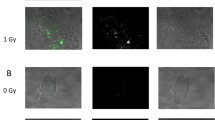Abstract
Delayed reproductive death, the appearance of colonies with a reduced cell density (impaired colonies) and the number of giant cells per colony were investigated in murine fibrosarcoma cells after irradiation with 3 to 9 Gy of x-rays. Radiation survivors were replated after reaching confluence, which occurred after 13 to 15 doublings; this procedure was repeated three times. The replating efficiency decreased in a dose-dependent manner, the survivors of 9 Gy achieving only 30% of the plating efficiency of unirradiated cells. After the third replating, i.e. after 40 to 45 doublings, the plating efficiency of the survivors approached that of the controls. The median colony size of the survivors showed a similar dose-dependent decrease, which was pronounced after the first replating but still remained significant after the third replating. The fraction of impaired colonies was increased to more than 30% in 9-Gy survivors, and though abating, the increase was still significant even after the third replating. Evidence of residual damage was also provided by the presence of giant cells. For instance, after 6 Gy irradiation and 13 to 15 doublings, the proportion of colonies with giant cells was 60%, decreasing only to 45% after 40 to 45 doublings. The number of giant cells per colony was 1.4 in colonies arising immediately after 6 Gy, decreasing to 0.9 after the third replating. These results suggest that the proliferative capacity of surviving cells is depressed even longer than their clonogenic capacity.
Similar content being viewed by others
References
Puck T, Marcus P (1956) Action of x-rays on mammalian cells. J Exp Med 103:653–666
Seymour C, Mothersill C, Alper T (1986) High yields of lethal mutations in somatic mammalian cells that survive ionizing radiation. Int J Radiat Biol 50:167–179
Chang WP, Little JB (1992) Delayed reproductive death as a dominant phenotype in cell clones surviving x-irradiation. Carcinogenesis 13:923–928
Brown DC, Trott KR (1994) Clonal heterogeneity in the progeny of HeLa cells which survive x-irradiation. Int J Radiat Biol 66:151–156
Chang WP, Little JB (1991) Delayed reproductive death in x-irradiated Chinese hamster ovary cells. Int J Radiat Biol 60:483–496
Beer JZ, Szumiel I (1994) Slow clones, reduced clonogenicity, and intraclonal recovery in x-irradiated L5178Y-S cell cultures. Radiat Environ Biophys 33:125–139
Jamali M, Trott KR (1995) Increased micronucleus frequency in the progeny of irradiated Chinese hamster cells. Int J Radiat Biol (in press)
Nias AHW, Gilbert CW, Lajtha LG, Lange CS (1965) Clonesize analysis in the study of cell growth following single or during continuous irradiation. Int J Radiol Biol 9:275–290
Kummermehr J, Trott KR (1977) Sensitization of a transplantable murine fibrosarcoma by partial synchronization with hydroxurea. In: Kärcher KH (ed) Radiobiological research and radiotherapy, Vol 1. IAEA, Wien, pp 427–442
Bristow RG, Hardy PA, Hill RP (1990) Comparison between in vitro radiosensitivity and in vivo radioresponse of murine tumor cell lines. I. Parameters of in vitro radiosensitivity and endogenous cellular glutathione levels. Int J Radiat Oncol Biol Phys 18:133–145
Jung H (1982) Postirradiation growth kinetics of viable and nonviable CHO cells. Radiat Res 89:88–98
Gorgojo L, Little JB (1989) Expression of lethal mutations in progeny of irradiated mammalian cells. Int J Radiat Biol 55:619–630
Fitzek M, Trott KR (1993) Clonal heterogeneity in delayed decrease of plating efficiency of irradiated HeLa cells. Radiat Environ Biophys 32:33–39
Mothersill C, Seymour C (1987) The influence of lethal mutations on the quantification of radiation transformation frequencies. Int J Radiat Biol 51:723–729
Born R, Trott KR (1988) Clonogenicity of the progeny of surviving cells after irradiation. Int J Radiat Biol 53:319–330
Mendonca MS, Antoniono RJ, Redpath JL (1993) Delayed heritable damage and epigenetics in radiation-induced neoplastic transformation of human hybrid cells. Radiat Res 134:209–216
Mothersill C, Seymour CB (1993) Recovery of the radiation survival curve shoulder in CHO-KI, XRS-5 and revertant XRS-5 populations. Mutat Res 285:259–266
Author information
Authors and Affiliations
Rights and permissions
About this article
Cite this article
Born, R., Kummermehr, J., Griebel, J. et al. The proliferative capacity of mouse fibrosarcoma cells that survived x-irradiation. Radiat Environ Biophys 34, 233–237 (1995). https://doi.org/10.1007/BF01209748
Issue Date:
DOI: https://doi.org/10.1007/BF01209748



